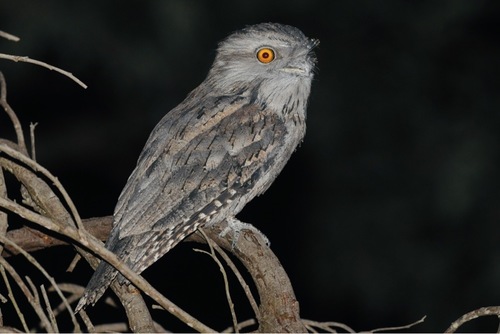
Tawny Frogmouth
The Tawny Frogmouth (*Podargus strigoides*) is a captivating bird species native to Australia, often mistaken for an owl due to its nocturnal habits and mottled grey plumage. However, it belongs to the frogmouth family, characterized by their wide, frog-like mouths. These birds play a crucial role in controlling nocturnal insect populations. They are also culturally significant, sometimes featured in Aboriginal folklore, and are generally viewed positively for their unusual appearance and pest-control abilities.
34-53 cm
Length
65-98 cm
Wingspan
Least Concern
Conservation Status
Distribution
Found throughout mainland Australia and Tasmania. They are absent only from the most arid deserts and dense rainforests. No significant migratory patterns are observed; they are largely resident birds.
Lifespan
Typically 10-14 years in the wild.
Tawny Frogmouth's Habitat
Habitat Types
Open woodlands, Savannas, Suburban parks and gardens, Eucalypt forests
Climate Zones
Temperate, Subtropical, Arid
Adaptations
Their excellent camouflage allows them to blend seamlessly with tree bark, making them virtually invisible during the day while roosting.
Variations
Three recognized subspecies exist: *P. s. strigoides* (eastern Australia), *P. s. phalaenoides* (northern and western Australia), and *P. s. brachypterus* (central and western Australia). These subspecies exhibit slight variations in plumage color and size.
Appearance
Breeding Plumage
Plumage remains relatively consistent throughout the year.
Seasonal Feather Changes
No significant seasonal variations.
Sex Based Plumage Differences
Males tend to have more silvery-grey plumage, while females often exhibit a more rufous (reddish-brown) tinge.
Notable Features
Wide, frog-like gape, Bristles around the beak, Large, forward-facing eyes (though not as large as owls'), Mottled grey and brown plumage for camouflage
Diet and Feeding
Primary Foods
Insects (moths, beetles, cockroaches), Spiders, Scorpions, Centipedes, Small vertebrates (mice, frogs, lizards - occasionally)
Foraging Behavior
Primarily a 'sit-and-wait' predator. Perches motionless on a branch and ambushes prey that comes within striking distance. They may also forage on the ground.
Specializations
The wide gape aids in capturing large insects. Bristles around the beak likely help in sensing and manipulating prey.
Seasonal Diet Variations
Diet may shift slightly based on prey availability, with a greater reliance on ground-dwelling prey during colder months when insect activity is reduced.
Behavior
Social Structure
Generally solitary or found in pairs. They are not known to form large flocks.
Communication
Low, booming 'oom-oom-oom' call (primarily by males), Hissing and bill-snapping when threatened, Soft chattering between pairs and family groups
Migration
Non-migratory; they are resident year-round within their range.
Territorial or Group Behaviors
Pairs defend a territory, particularly during the breeding season. Territory boundaries are often established through vocalizations.
Conservation
Threats
Habitat loss (due to land clearing for agriculture and urbanization), Pesticide use (reducing insect prey populations), Road mortality (collisions with vehicles), Predation by cats and foxes
Protection Programs
Habitat restoration and protection initiatives, Public awareness campaigns promoting responsible pet ownership (to reduce cat predation), Encouraging the use of wildlife-friendly pest control methods
Local National Laws
Protected under state and territory wildlife legislation across Australia.
Population Trend
Stable
Population Estimates
While precise figures are difficult to obtain, the population is considered widespread and relatively common, though localized declines may occur.
Interesting Facts
They are often mistaken for owls.
Despite their similar appearance and nocturnal habits, Tawny Frogmouths are more closely related to nightjars.
They can 'freeze' to mimic a broken branch.
This camouflage tactic helps them avoid detection by predators during the day.
Their eyes are not as large as those of owls.
Owls rely more heavily on vision for hunting in low light, while frogmouths also use their sense of touch (via bristles) and hearing.
They help control insect populations
This is good for the surrounding environment.
Faqs about Tawny Frogmouth
Are Tawny Frogmouths owls?
No, they belong to a different family of birds called the Podargidae (frogmouths). They are more closely related to nightjars.
What do Tawny Frogmouths eat?
They primarily eat insects, spiders, and other invertebrates. They may occasionally eat small vertebrates like mice or frogs.
Where do Tawny Frogmouths live?
They are found throughout Australia and Tasmania in a variety of habitats, including woodlands, savannas, and even suburban areas.
Are Tawny Frogmouths endangered?
No, they are currently classified as 'Least Concern' by the IUCN. However, they face threats from habitat loss and other factors.
Copyright @ Nature Style Limited. All Rights Reserved.
 English
English